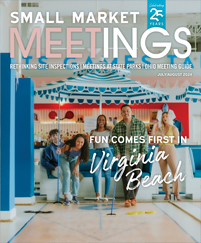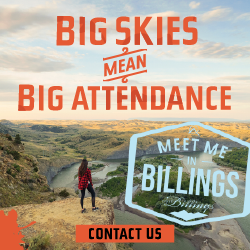During the pandemic, trade shows became all but extinct. Neither clients nor suppliers wanted to be face-to-face and elbow-to-elbow, and for a time, the phone, email and Zoom stood in for in-person meetups. In 2022, trade shows started trickling back, and this year, they have snowballed, in some cases with turnouts near or at pre-pandemic levels.
Here’s a look at some trends and interesting ideas from recent shows.
Shifting to smaller cities and venues
Trade shows, of course, have always come in different sizes, from CES (the Consumer Electronics Show), which had more than 3,200 exhibitors in Las Vegas in January, to the small education conference with 10 suppliers set up at six-foot-long tables. But multiple industry experts are predicting that because of COVID and the aversion to the crowds it has created, some trade shows will intentionally downsize and migrate to second-tier destinations and smaller convention centers. The president of the International Association of Exhibitions and Events, David DuBois, has said this trend could help make shows more personal and engaging. There’s also some evidence that exhibitors might find smaller shows more effective. In one study, one-third of exhibitors said their best results came from large national shows, while 53% said regional shows were more fruitful for them.
Seeking sustainability
Experts also say there’s a growing concern about trade shows’ environmental footprint. They predict that exhibitors and attendees will increasingly demand more in terms of energy conservation, recycling and waste reduction. A start for any organizer is to supply water bottle refilling stations and discourage the use of brochures and pamphlets and other sales materials as well as plastic bags and pointless SWAG. As trade show organizers look harder at venues’ environmental practices, facilities like the Overland Park Convention Center in Kansas could emerge as winners. In a dedicated section on its website, the Overland Park center outlines the measures it takes to reduce, reuse and recycle, from turning lights down in the exhibit hall during move-in and move-out to partnering with a local organization to send leftover food to those who need those nutritious meals. Organizations that want to take a more sustainable approach to their events can look to the Net Zero Carbon Events (netzerocarbonevents.org) initiative for guidance.
Getting education out on the floor
Another change wrought by the pandemic might be airing out the exhibit hall floor a bit. There are several ways to do that, including creating stages or classrooms on the exhibit hall floor, which gives attendees a place to go and sit a spell and learn something new. It also keeps attendees from oozing out of the exhibit area. Depending on the size of the show, these spaces can vary in size and number. At the Food Safety Summit in May at the Donald E. Stephens Convention Center in Rosemont, Illinois, for example, attendees could adjourn to the Tech Tent, for 30-minute demonstrations of food safety tech presented by exhibitors or to the Solutions Stage for presentations. At the Sweets and Snacks Expo in Chicago, four stages offered presentations built on the themes of eye openers, insights, innovations and inspirations. Organizers can also make room for roundtable discussions, which not only educate but also promote networking. Another upside to these spaces? They can become sponsorship opportunities, a way for an association or organization to make a conference more financially solid.
Making space for fun
Giving conference-goers some spaces to relax or have some fun will also keep them in the exhibit hall longer and promote conversations and connections with their peers and exhibitors. At the Specialty Coffee Expo, held earlier this year in the coffee capital of Portland, Oregon, Roaster Village was a natural. It’s where a few exhibitors get to perk and pour, and everyone else enjoys the aroma and an invigorating cup or two. At this year’s National Association of Music Merchants Show in Anaheim — a whopper with almost 50,000 attendees — live music was performed during the trade show, some of it on a stage as large as the one used at Coachella. Competitions can also add some excitement. At the Wild Sheep Foundation Expo in Reno, where several bars dot the trade-show floor, competitors see who can best pack up supplies for a backcountry trip using life-sized models of horses. At the Surf Expo in Florida, artisans compete in the Florida Shape-off, which promotes the craft of hand shaping surfboards.
Connecting through tech
Organizers who employ as much technology as possible will win ahead of both exhibitors and attendees. Seasoned sales representative realize it takes more than a few minutes of conversation in a trade show booth to cement a business relationship, and they appreciate having the ability through varied tech to touch base with attendees, before the show and after. For example, a first-time exhibitor at a large conference for home design said being on the conference app and social media were critical to building awareness of his company’s brand and making connections beforehand. Attendees also appreciate having different technologies to map out their time among hundreds of exhibits. Another way organizers can aid attendees and exhibitors is by laying out the show floor in interesting ways. For example, at the Sweets and Snacks Show in Chicago, manufacturers with under three years’ experience were lined up on Startup Street. Some exhibitors, realizing that attendees like to have nice places to take a break, are incorporating meeting rooms and lounges in their booth designs. It’s a way to offer a VIP experience and possibly start a new business relationship.











